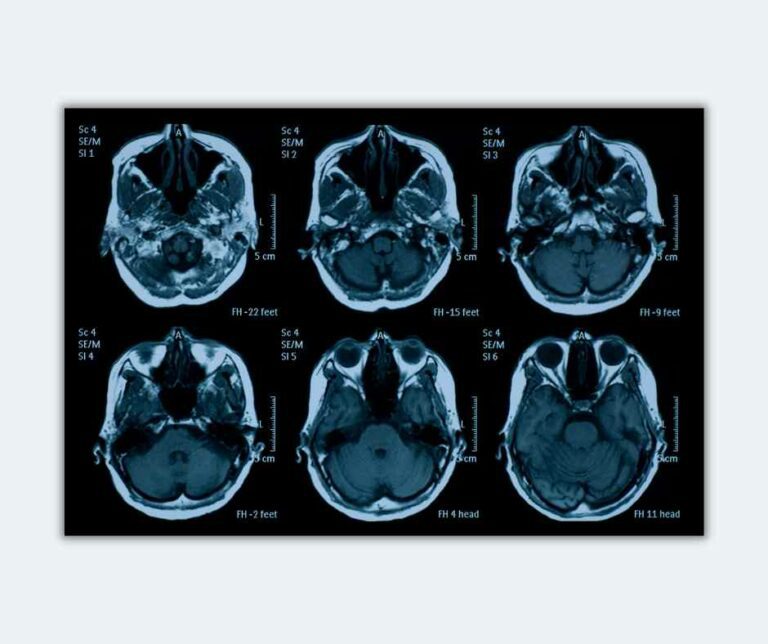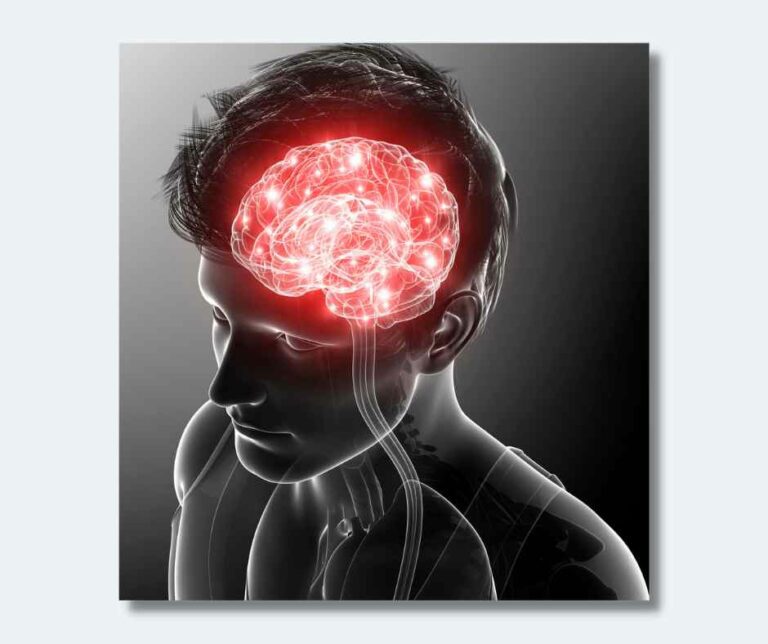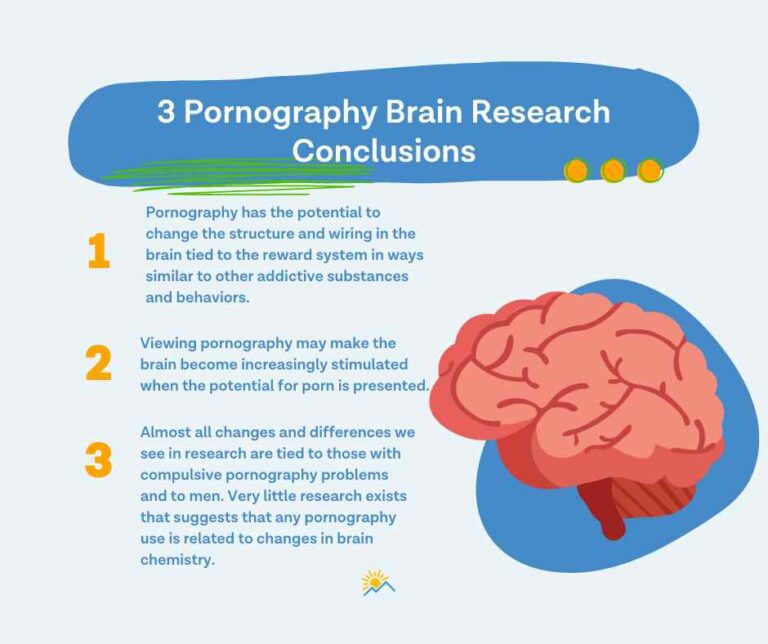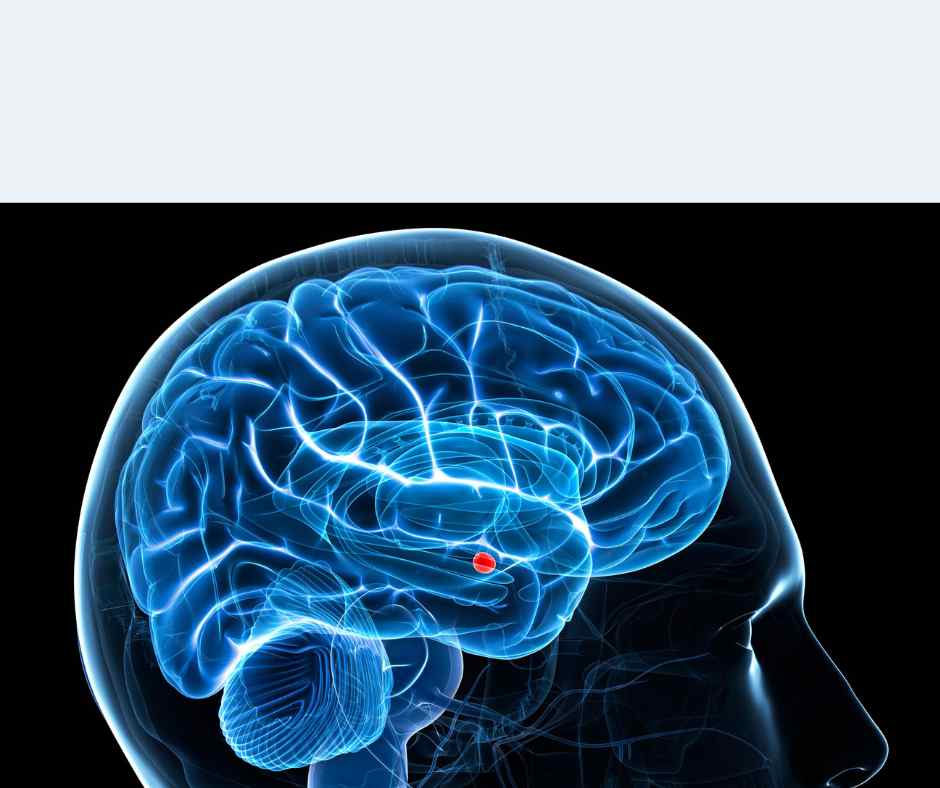One of the most common rumors circulating around the internet is that porn is just as damaging and addictive to the brain as cocaine, meth, and other addictive substances. This argument has been based on the claim that such comparisons are tied to existing pornography brain research. Often those who oppose pornography use such claims as a justification for harsher laws restricting pornography use – and as a tactic to persuade others regarding the dangers of pornography.
Yet many others have claimed that these so-called research “facts” have been greatly exaggerated or are simply false. So what is the truth?
Table of Contents
- Challenges of surveying the brain science
- Examining 6 major pornography brain research studies
- Study 1: key study linking brain chemistry and function to porn
- Study 2: focused on compulsive pornography users
- Study 3: review of previous research on pornography and the teenage brain
- Study 4: pornography brain research on problematic porn users
- Study 5: a broader look at brain structure and activity associated with rewards
- Study 6: pivotal study that included men and women
Challenges of surveying the brain science
Like many areas of social science research, the truth is often a bit more complicated than many would like you to believe. The problem in many of these debates is that the authors of various articles, videos, or websites on this topic rarely provide their readers with the actual facts and specifics of the research studies themselves (sometimes even failing to cite any of the “research” they claim to be drawing from). Instead of trying to present objective data and allow the reader to come to their own conclusions, they often seek to sensualize information, cherry-pick only data that supports their opinion, or omit data that contradicts their views.
This can make understanding what is real and not real when it comes to brain research on pornography challenging. But we’re here to help! When you study the actual research and try to understand the nuances of these findings, a better understanding of what the brain research focused on pornography does and does not show becomes clear.
This resource is designed to help you understand the brain science on pornography in a straightforward and honest way. Sure, we don’t hide the fact that we believe individuals, couples, families, and society would be better off without pornography. But we also believe that an honest assessment of the research will help us move toward that goal in a more efficient and straightforward way than spreading lies and half-truths on the internet. We also believe that educating you, the reader, will help you be more articulate and knowledgeable as you talk about this topic with others. And that can only help the cause! So let’s jump in!
Examining 6 major pornography brain research studies
To help you understand the brain science in this area, we’ve avoided writing up a lengthy (and boring!) literature review on the topic. We’ve also not compiled an exhaustive list of every study ever conducted on the topic. Instead, below we’ve summarized a handful of the latest and most influential studies on this topic.
In most cases, we’ll give you a quick summary of the findings, then a slightly longer overview of the study itself. We’ve also provided links to each study just in case you’d like to go read the details yourself. As you’ll see, as you begin to look at the research in this area, a few clear patterns begin to emerge. We’ll summarize those patterns at the end.
A quick note: almost all these studies utilize brain imaging techniques to collect data (for example, fMRIs). We won’t get into those technical details below. Just know these are procedures that allow the researchers to take pictures of the brain and understand brain activity and chemistry.

Study 1: key study linking brain chemistry and function to porn
The Study: Brain Structure and Functional Connectivity Associated with Pornography Consumption: The Brain on Porn
Let’s start with a big one. This paper was published in 2014 in one of the top journals of the American Medical Association. It’s now been cited over 100 times and is a key study linking brain chemistry and function to pornography use.
The Bottom Line:
These researchers were interested in understanding if pornography use influences the brain similar to other reward seeking addictive behaviors. They found that frequent pornography use was associated with differences in brain structures and neuro-connections. Most of these changes were associated with brain activity that would suggest an increased frequency of pornography use was needed to trigger reward centers in the brain. This provided evidence that pornography use does function in a similar way to other addictive substances in how it begins to shape and cultivate changes in how the brain processes rewarding stimulus.
The Details:
This brain study is unique in that it did not focus exclusively on heavy compulsive or addictive pornography users. Instead, the researchers sampled 64 males with a wide range of pornography use frequencies. They were interested in if pornography use was associated with brain structures in ways that would suggest pornography use functions similar to other behaviors that create pleasurable sensations in the brain tied to reward. When we engage in behaviors that we find rewarding, our brain eventually restructures itself to attempt to continue seeking that reward.
In their sample the men averaged about 4 hours of pornography use per week, something you’ll notice is rare in most of these studies. During the screening of participants, the researchers found that about a third of their sample was at risk for pornography addiction. The researchers took images of the subject’s brain and showed them explicit pornographic images to see how their brains reacted to this stimulus.
The findings of the study fell into the two broad areas. First, they found that the number of pornographic hours per week was associated with differences in brain structure. Those that watched more porn per week had brains with slightly different composition, suggesting that as pornography viewing increases, the brain begins to shift in response to consistent sexual stimuli.
Second, they found that those who watched pornography more often had less brain reaction when presented with sexually explicit images, suggesting that for those who view pornography regularly, pornographic material is less stimulating to the brain. This may suggest that as pornography viewing increases, there is a need to watch additional pornographic material to create the same sensation in the brain.
The researchers were quick to point out that because the study was cross-sectional, it is possible pornography use causes these changes in the brain, but it may also be possible that these brain differences pre-existed pornography use behaviors. So, those with brain structures that are more likely to be stimulated by pornography are also more likely to seek out pornographic material. The general conclusion, however, was that pornography does appear to have similar effects on the brain as other addictive behaviors, suggesting that pornography can indeed be an addictive behavior.

Study 2: focused on compulsive pornography users
Study 2: Sexual cues alter working memory performance and brain processing in men with compulsive sexual behavior
This more recent study was published in 2020 in the journal NeuroImage. It was focused on compulsive pornography users and how their brains react to sexual stimuli.
The Bottom Line:
The focus of the study was to explore the brains of those who were struggling with compulsive sexual behavior with a focus on pornography use. The researchers showed both control images and pornographic material to the participants which included 38 people struggling with compulsive sexual disorder and 31 healthy controls.
The findings of the study suggested that when confronted with pornographic images, the brain reaction times of those with compulsive sexual disorder were different than those in the control group. They found evidence that compulsive users were more distracted by pornographic images, suggesting that they were more likely to linger on these images than those in the control group. This provided more evidence that the brain of compulsive users reacts differently to sexual images, perhaps due to changes that have occurred over time from viewing a lot of porn.
The Details:
Like many brain studies tied up in brain science, this study was focused on those already diagnosed with compulsive sexual behavior. To be included in the study, the researchers carefully screened for those with heavy pornography use to ensure that those in the study were not experiencing distress simply due to moral beliefs or religious beliefs against pornography.
They also administered clinical assessments of compulsive sexual disorder to ensure that those in the compulsive pornography group displayed clinical levels of distressing use. They then compared these people to a control group. During the study, both those in the compulsive sexual behavior group and the control group were shown a variety of pictures, including those depicting pornographic material and neutral pictures of couples jogging.
When analyzing their findings, one of the things the researchers found was that when shown pornographic pictures, those in the compulsive sexual group appeared more distracted by these images. Their brains appeared too slow when trying to complete other tasks when presented with sexual stimulus prior to the task.
They also found that those in the compulsive sexual group were more likely to remember the pornographic pictures they had seen after the main experiment was over in a recall task the researchers used. This suggested that sexual images linger in the brains of pornography addicts longer than for those in the control group.
The researchers explained these differences by suggesting that those in the sexual compulsive group were more likely to focus on and study the pornographic pictures when they were presented compared to those in the control group. As a final analysis, they also noted that the brain areas typically stimulated by sexual stimuli were more activated by pornographic images among those in the sexual compulsive group.
This finding was explained by the researchers as likely being due to the fact that heavy pornography users have trained their brain to be more stimulated by pornographic material. Overall, findings suggested that the brains of pornography addicts react to porn differently than those in the control group. Like other studies, it was unknown if these differences pre-dated pornography use or were caused by excessive pornography use over time.
Like similar studies, these results need to be contextualized by the fact that both the compulsive sexual disorder and the control groups had regular pornography use. In the case of this study, those in the compulsive sexual group averaged about 5 to 6 hours per week of pornography use. By comparison, those in the control group averaged about 1 hour of pornography use per week.
This is a very important distinction because it suggests that these results and the differences found are likely due to heavy or compulsive pornography use, not any pornography use.

Study 3: review of previous research on pornography and the teenage brain
The Study: The components of the adolescent brain and its unique sensitivity to sexually explicit material
Shifting gears slightly, this study was published in 2019 in one of the top adolescent development journals. Unlike the first two studies we’ve summarized, this one focused on the teenage brain. Unlike the other two as well, this was not an original research study, but a review of previous research on pornography and the teenage brain. For that reason, we’ll just give a summary of the main points of the article.
The Details:
Since this wasn’t an original study, we’ll just get right to the good stuff. These researchers started by highlighting how the adolescent brain is different from an adult brain. Here are some of the differences they highlighted: the prefrontal cortex is underdeveloped in teenagers, the part of the brain that produces dopamine is overactive in teenagers, and the brain is more prone to change in teenagers.
The next part of the article summarized previous research on how pornography (they label it as sexually explicit material) influences the brain. This summary highlighted similar findings to other studies we’ve summarized in this resource. For example, they noted that pornography triggers specific chemical releases in the brain tied to pleasure and that research has suggested that heavy pornography users show differences in the structure of their brains compared to those who use pornography less frequently.
They then blended these two areas of research with existing research on pornography use in adolescence to propose some suggestions on how pornography may influence the adolescent brain uniquely. Their main argument was that if porn influences the prefrontal context and this area is underdeveloped in the teenage brain, teen brains will be more influenced by pornographic images.
Specifically, they argue that this research would suggest that adolescents would act more impulsively and more irrationally when viewing pornography. Since the teenage brain is also more prone to change, this may lead to a “short circuiting” of the prefrontal cortex that can quickly lead to the brain changing or rewriting neurons to facilitate what the researchers labeled as “self-gratification.” This would be compounded by the fact that the teenage brain would also be likely to release more chemicals in reaction to porn, since teenage brains are still learning to regulate the amount of chemicals released when encountering various stimuli.
Sound complicated? Well, to simplify their main conclusion consider this. Teenage brains are likely more sensitive to pornographic content than adults. This means that when teens are exposed to pornography, they may be more likely to develop both compulsive or addictive behaviors tied to porn and be more likely to experience brain changes due to regular pornography use. Researchers noted that larger studies are needed to verify these conclusions, but that these are likely results based on existing research at the time.

Study 4: pornography brain research on problematic porn users
The Study: Can Pornography be Addictive? An fMRI Study of Men Seeking Treatment for Problematic Pornography Use
Let’s move on to another big study. This 2017 study was published in the journal Nature, one of the most prestigious scientific journals in the world. It has been cited over 200 times since it was published (that’s a lot!), suggesting that this is one of the most important studies in this area.
The Bottom Line:
The main goal of this study was to understand the brain of those who struggle with problematic pornography use (PPU), another label sometimes given to those with addictive or compulsive pornography problems. Like similar studies, they looked at two groups of men, one with PPU and a control group. The researchers looked at how the brains of these two groups responded to sexual stimuli. They found that when prompted about a possible pornographic reward, those with PPU had a stronger urge to view pornographic images, and that their brains were more stimulated by this potential sexual content. They noted that this brain response was similar to what has been observed in research with both gambling and substance use addictions.
The Details:
The story here is a similar one. How does the brain of a pornography addict look different from those in a control group? Like other studies we have summarized, the research took two groups of men, 28 with PPU and 24 in a control group (are you noticing a trend of very small samples?) and explored differences in their brains. They presented these two groups with three different potential stimuli while they completed a task; a reward or porn, a reward of money, or no reward. The men in the PPU group were those seeking professional treatment at the time for their pornography use. The design here was somewhat unique. They first showed the men a picture telling them what the reward was for the task they were about to do was, either an erotic picture or money (or no reward). They then had a delay in the task meant to measure anticipation in the brain. Then they had to complete a cognitive task to receive the reward (again, either money or an erotic picture). Their brains were monitored the whole time.
The findings were interesting and set the groundwork for many studies that have taken place in the last few years. They found that men with PPU had very different responses to the “cue” of erotic reward. Meaning that when they knew the reward was porn, their brain was more active, and they were more motivated to complete the task compared to when the “cue” was a monetary reward or no reward. The researchers argued that this could suggest a conditioning effect on the brain, where men with PPU have trained their brain to seek out the reward of erotic images.
This was compounded by the fact that the men with PPU were less motivated and had less brain stimulation in tasks where they knew there was no reward at all compared to the control group. This may suggest that men with pornography addictions struggle to be motivated to complete work or daily tasks that are not associated with pornography.
There are some limitations here. Remember, these findings were just for men and just for those with addictive pornography use. And yes, once again if you look at the pornography frequency numbers, you’ll see that while those in the PPU group averaged just under 6 hours per week, and those in the control group averaged almost an hour of porn viewing a week.
This suggests that differences seen are likely due to heavy and compulsive use of pornography, not to pornography use in general. But these results are important in that they suggest that brain differences are not just based on watching porn, but on brain activity prior to watching porn.

Study 5: a broader look at brain structure and activity associated with rewards
The Study: Aberrant Orbitofrontal Cortex Reactivity to Erotic Cues in Compulsive Sexual Behavior Disorder
Moving from a major study to a slightly less known and more recent paper. This 2021 study was published in the Journal of Behavioral Addictions and provides an important caveat to the research we have summarized up to this point.
The Bottom Line: In many ways, this was a replication of the study we just summarized published in Nature. Here the method was very similar, looking at a group of men with compulsive sexual disorders and a group of men in a control group. After telling them they were about to receive either a monetary or erotic reward, they looked for any brain differences in activity both prior to receiving the reward and after.
The additional value of this study was that they took a broader look at brain structure and activity, exploring previously unexplored parts of the brain associated with rewards. This examination found that results from previous studies were replicated in both previously studied and new areas of the brain. Those with compulsive sexual disorder had more brain stimulation (in multiple parts of the brain) when they knew the reward was porn. This replicated and extended previous findings.
The Details: You’re probably starting to get the idea of this research by now, so we’ll give you the quick facts. This study had 29 men who had compulsive sexual disorder and 24 in the control group. It is important to note that these researchers had a broader definition of compulsive sexual disorder than some of the previous studies summarized.
These men were often not only viewing porn excessively but engaging in a variety of compulsive sexual acts. The researchers did not report specific pornography viewing frequencies between groups, but did note that all men in the control group reported viewing porn at least once in the last year.
As noted above, the method here was very similar to the study published in Nature. Those in the study were told what the reward for the upcoming task was (porn or money). They were then told to wait for a random amount of time, then asked to complete a simple task. Once completed, they were shown the reward. Brain activity was monitored throughout the activity.
Their results were very similar to other studies, largely replicating the findings from the earlier Nature paper. They found that men with compulsive sexual disorder had higher brain activity when told the reward was porn at the end of the task.
Like previous scholars, these researchers’ assumption was that this heightened brain activity was likely due to conditioning that had occurred over time as these men viewed porn at a frequent rate. Their research built on earlier studies, because they looked at new areas of the brain, again noting differences between men with compulsive sexual disorder and the control group. This provided more evidence that the reward center of the brain is reacting to porn differently among those who have viewed porn excessively and compulsively in the past.

Study 6: pivotal study that included men and women
The Study: No sex difference found: Cues of sexual stimuli activate the reward system in both sexes
We know a question you may be asking yourself at this point. Is all this research only about men? Historically women have been often overlooked when it comes to pornography research. However, researchers have begun to look at if these brain differences noted in other studies also appear in females. Let’s look at a 2019 study published in the journal Neuroscience, a pivotal study that looked at both men and women simultaneously.
The Bottom Line: The title kind of spoils the punchline here! Using the tried-and-true method of presenting people with sexual stimuli and seeing how their brain reacts, this study took the novel approach of looking at both men and women. Their results were interesting in that they noted very few differences between men and women, suggesting that brain activity tied to the presentation of porn was very similar for both men and women.
In both sexes, viewing sexual stimuli, or knowing you were going to see porn was associated with increased activity in the brain. They researchers noted this is important because it suggests that differences in porn use (that men use porn more than women), is not explained by sex differences in the brain. Interestingly these researchers found no differences in the brain activity of subjects based on either the amount of porn they viewed or the age in which they started to view porn.

The Details: We’ve all heard that men watch porn more than women. This fact has been shown in countless research articles. Yet almost all research on the brain has been solely focused on men. This study sought to fix this problem by replicating the familiar method of other studies, but looking at both men and women in the same study. Their question was simple. Would porn viewing also be associated with differences in the brains of men and women in terms of how the brain reacted to porn?
Here the researchers simply looked at a group of men (37) and a group of women (33). In full disclosure, most of this sample consisted of college students recruited from the campus of the researchers doing the study. They presented these men and women with either pornographic pictures, pornographic videos, or neutral pictures and videos.
The researchers did some preliminary work to make sure the pornographic content was equally arousing to both men and women. The neutral pictures and videos showed couples doing everyday tasks together. The researchers did tell the participants what was about to be presented to also gauge brain activity in anticipation of the pornographic material.
They generally found across the entire sample that the brain was more stimulated when presented with sexual material compared to neutral material. However, they also found that some brain activity was different for men and women. Their brains reacted slightly differently to the sexual stimulus, a fact that the researchers thought may be due to men finding the images and videos more attractive. This was confirmed with survey data also collected, despite the efforts of the researcher to make the pornographic images equally arousing to both sexes.
These sex differences were small for the most part, suggesting men and women tend to have a similar reaction to porn in the brain. Importantly, when they examined the effect of pornography use and the age at which the participants started to look at porn, they found no differences between men and women.
In fact, they generally found that these factors played little part in predicting activity in the brain during the experiment. In other words, in this relatively normal sample, porn use didn’t appear to have that much of an impact on brain activity when presented with porn, and this held for both men and women.
While this may seem to contradict the other studies summarized, this is likely because these scholars were not focused on excessive or compulsive use of pornography (the type of pornography use found to influence the brain in these other studies).

Summarizing Pornography Brain Research
There are several themes that can be taken from this collection of studies. The first is that it does appear to be true that the pornography use is associated with changes in the brain! Specifically, there appears to be two themes to these brain differences.
First, the portion of the brain that is tied to rewards (making you feel good when you do something) appears to function differently among those who have watched porn excessively or compulsively.
When individuals use pornography often, it appears that their brains react to sexual stimuli in ways that are different from those that don’t use pornography often. While some of this research suggests that sexual material is less rewarding to those that use pornography often, other studies suggest that when pornography addicts know they are about to view porn, their brains are much more active than those without an extensive porn history.
To put all of that into context, there are basically three main conclusions we can draw from this research:
Conclusion 1:
Pornography has the potential to change the structure and wiring in the brain tied to the reward system in ways similar to other addictive substances and behaviors.
Conclusion 2:
Viewing pornography may make the brain become increasingly stimulated when the potential for porn is presented (potentially leading someone to crave porn).
Conclusion 3:
However, the above conclusions appear to mostly (and potentially only) be true for those with compulsive and additive patterns of pornography use. Those with these compulsive patterns also likely have less brain stimulation in the reward centers of the brain when watching porn, requiring longer viewing sessions to create the same rewards in the brain over time.
It is also important to remember that many of these studies exploring differences between a group of pornography users and a control group include pornography users in both groups.
In most of these cases, the pornography user group is comprised of a group of men who are compulsive users often using pornography five to ten hours per week. This is contrasted with the control group that often includes individuals who use pornography for less than an hour a week but still view it regularly.
This means that Conclusion 3 above is critical to understanding the existing research linking the brain to pornography. Almost all changes and differences we see in research are tied to those with compulsive pornography problems and to men. Very little research exists that suggests that any pornography use is related to changes in brain chemistry. Instead, the consensus of this research is that heavy or compulsive pornography use likely is related to differences in brain structure and function.
Remember, most researchers are cautious to generalize these results because it is unknown if pornography has caused these changes to the brain or if these changes predate pornography use. It’s very unclear at the moment if people who use pornography compulsively simply have brains with different wiring (making them more likely to be porn addicts), or if porn is actually causing changes over time.
There are a few more conclusions to gleam from these studies. As noted in Study 3, teenage brains may be particularly at risk when it comes to pornography (although we need much more research on teenagers to make any conclusion here). Limited research also suggests that many of these patterns may be similar for men and women, although there is very limited research on women. There is a desire for researchers to branch out and explore how pornography is related to brain chemistry and function beyond adult men, but this research is slow and just in the early stages.
Does this mean that most porn use doesn’t impact the brain? Not necessarily. Keep in mind that researchers have also mostly focused their studies only on the reward centers of the brain. It is unknown how porn use at any level may impact other parts of the brain (for example, those parts of the brain responsible for releasing chemicals tied to romantic relationship bonding and love). We simply don’t have research to draw these conclusions yet.
Probably the best thing to take from this research is this. Excessive porn use probably impacts the brain in some way. However, our knowledge about anything beyond that is very limited. We should be very cautious about making claims about what porn does or does not do to the brain and certainly avoid comparing pornography to substances like meth or heroin. Even if some of the addictive processes in the brain are similar, these substances will create addiction in anyone that tries them. The path to addiction with pornography is much murkier, and the research is much more limited. The day may come when we know much more than we do today, but for now, we’ll have to be content knowing that there is more to study and explore moving forward.
14-Day Free Trial
Protection From Pornography
Change your habits, change your life: Start our 14-day free trial to help get rid of pornography for good.





